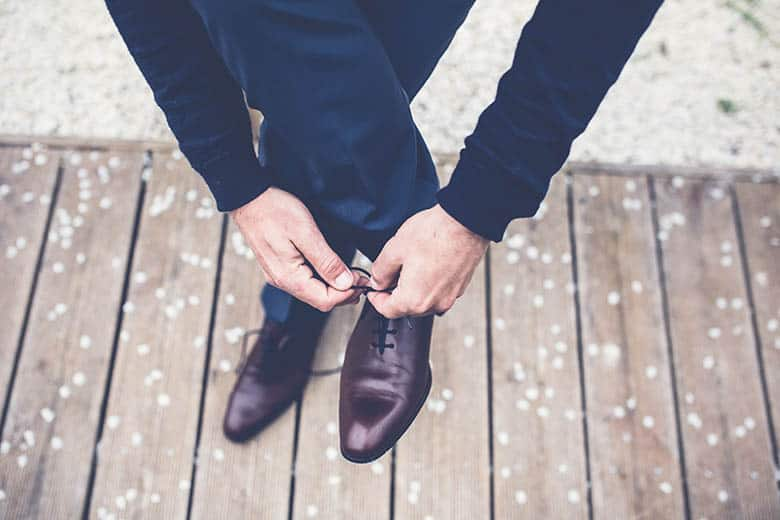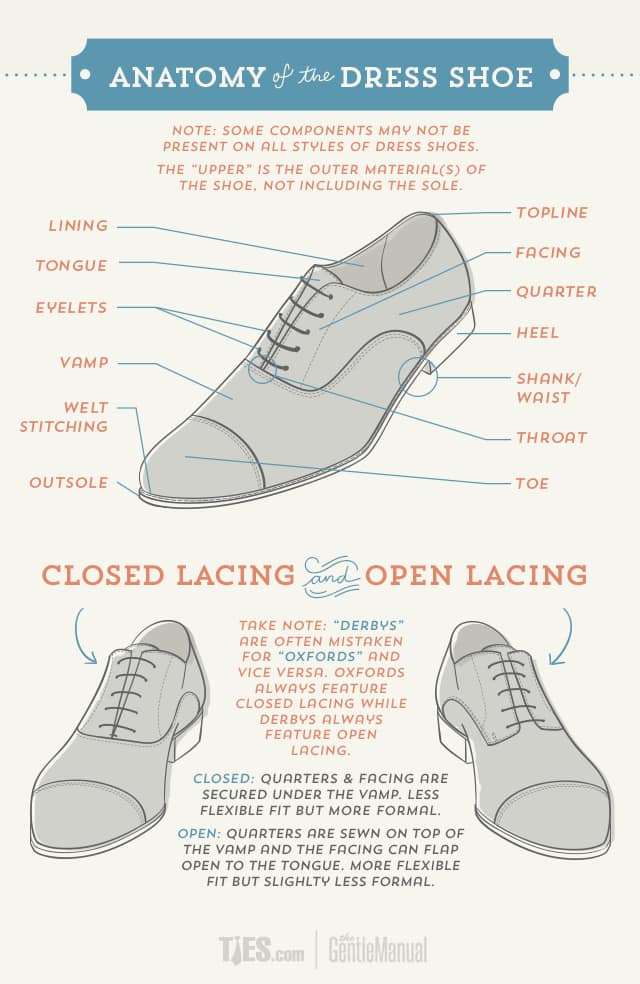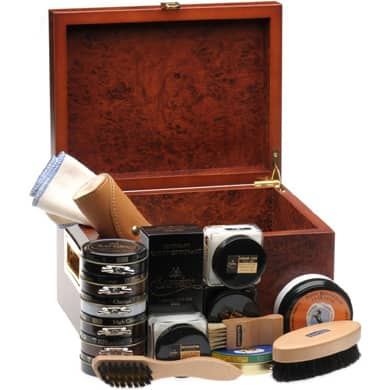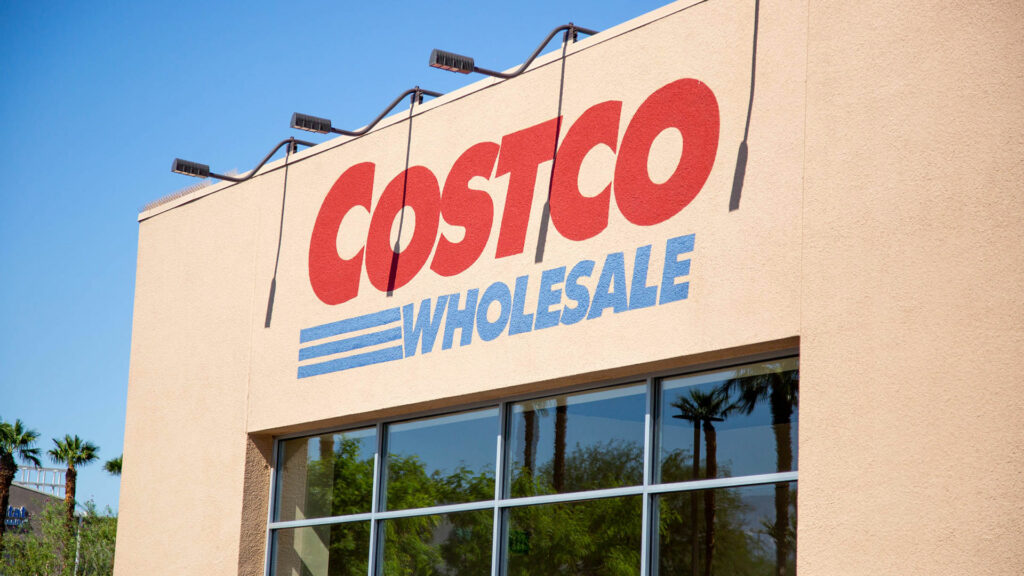Advertiser Disclosure: At Slickdeals, we work hard to find the best deals. Some products in our articles are from partners who may provide us with compensation, but this doesn’t change our opinions. Our editors strive to ensure that the information in this article is accurate as of the date published, but please keep in mind that offers can change. We encourage you to verify all terms and conditions of any product before you apply.
Reading Time: 10 minutes
Many men today, especially in hyper-casual America, treat their dress shoes as a mere afterthought — items to be dragged out only when necessary, worn for a few hours and then stuffed back into the closet. Despite this, dress shoes remain one of the most important parts of a man’s wardrobe. Some style aficionados even go so far as to say that shoes are the most important part of an outfit, as a pair of shoes can make or break the whole ensemble.
If, like many men, you only own one or two pairs of cheap dress shoes to attend weddings, funerals or job interviews, please read on. We’re here to give you a basic run-down of what a man needs to know about dress shoes, as well as what to look for in a quality pair. We’ll even include the details on leather grade and construction methods. These are things that your grandfather and great-grandfather almost certainly knew about, but men today barely give any thought. It’s time to fix that.
Table of Content
- What Makes a Shoe a “Dress Shoe?”
- Styles and Features
- Comfortable Dress Shoes
- Types of Leather
- Constructions Counts
- Choosing the Color
- Shoe Care
- When, What, Where to Buy
What Makes a Shoe a “Dress Shoe?”
Let’s get a few important things out of the way right off the bat: loafers are not dress shoes. Black tennis shoes are certainly not dress shoes (no, it doesn’t matter if they have “leather” in them). Loafers are casual and tennis shoes are athletic wear. Those chunky-soled square-toed abominations are also absolutely not dress shoes.
What makes a true dress shoe distinct from other footwear is shape, material, construction and style. A dress shoe shape (or “last,” from the handmade wooden molds craftsmen use to form the shoes) should be sleek and not boxy or chunky. A dress shoe shouldn’t look like a pointy-toed elf shoe, but the shape should be slim, narrow towards the toe, and follow the lines of the foot. Overly round, boxy or square-toed shoes create odd and unnatural shapes that are distracting and displeasing to the eye.
A proper dress shoe will also have a thin sole, adding to the overall sleek lines that a fat, thick sole will break up. Dress shoe soles are usually made of leather, although, as Slickdealer thin rubber soles may be preferable for your “wet weather” pair. Some modern shoes use combination soles that are mostly leather, but with some rubber added for traction, usually on the heel.
There are a number of acceptable dress shoe styles from Oxfords to dress boots. A proper dress shoe should also be well-constructed of quality leather. We’ll take a look at styles, leather grades and construction methods below.

Styles and Features of a Dress Shoe ^
The standard dress shoe is the classic Oxford. This is not to be confused with a Derby or a Blucher, although they may look similar. The difference is in how they are constructed: Oxfords feature “closed lacing,” whereas the lacing on Derbys and Bluchers is “open.” The graphic above illustrates the difference between opened and closed lacing.
Derbys and Bluchers will often be advertised as Oxfords in the U.S., as Americans have typically not made as much of a distinction between the two. Keep in mind that Oxfords are dressier, whereas open lacing is more casual and less clean-looking. For a proper dress shoe, Oxfords are almost always the better and more versatile choice.
 Two other styles that have become more popular lately include wholecut and monk strap shoes. Wholecuts, as their name implies, feature a vamp cut from one solid piece of leather rather than stitched together in sections like most shoes. Wholecuts are generally considered a type of Oxford and are often advertised as such.
Two other styles that have become more popular lately include wholecut and monk strap shoes. Wholecuts, as their name implies, feature a vamp cut from one solid piece of leather rather than stitched together in sections like most shoes. Wholecuts are generally considered a type of Oxford and are often advertised as such.
Monk strap shoes are admittedly a “love it or hate it” sort of thing, but have nonetheless become highly popular in recent years. Instead of lacing, monk strap dress shoes use a strap-and-buckle closure. Monk straps are considered more casual than Oxfords, but more formal than Derbys and Bluchers.
 Dress boots are less common these days, but were very popular in centuries past, and actually pre-date the modern dress shoe. Two notable dress boot styles are Chelsea and jodhpur boots, both hailing from England. Chelsea boots have a short shaft and elastic webbing on the sides for ease of putting on and taking off, as they have no laces. Jodhpur boots also have no laces and feature a leather strap and buckle closure. There are also many dress boots that are simply Oxford or Derby-style shoes with longer shafts.
Dress boots are less common these days, but were very popular in centuries past, and actually pre-date the modern dress shoe. Two notable dress boot styles are Chelsea and jodhpur boots, both hailing from England. Chelsea boots have a short shaft and elastic webbing on the sides for ease of putting on and taking off, as they have no laces. Jodhpur boots also have no laces and feature a leather strap and buckle closure. There are also many dress boots that are simply Oxford or Derby-style shoes with longer shafts.
Dress shoes often feature different types of styling on and around the toe and laces. One of the most basic and popular of these is the “cap toe,” where the toe of the shoe or boot is a separate piece of leather stitched to the vamp. This creates a clean line along the top of the foot and is very common on Oxfords. Another popular styling feature is brogueing, which is a series of holes punched in the leather along the seams. Brogued shoes often have a punched design on the toe box as well, usually referred to as a “medallion.”
Brogueing is frequently seen on cap-toes as well as wingtip shoes, which were popular in the early and mid-twentieth century and have been undergoing a bit of a revival lately. Cap-toe shoes may or may not feature brogue patterns, but wingtips almost always do. Note that while brogue and wingtip styling on dress shoes is considered slightly more casual than a plain Oxford, it is an excellent way to spruce up an otherwise conservative outfit, and can also be dressed down with chinos or dark jeans easily.
Comfortable Dress Shoes ^
If dress shoes are part of your work attire, it’s important that they not just look nice and professional, but they also need to be comfortable. Adequate arch support is key, especially if you have flat feet or suffer from supination. Unfortunately most dress shoes lack proper support, but you can always buy insoles to help with that. Dr. Scholl’s are well-known and affordable, but they’re not the best quality. Something more robust and supportive, but still comfortable, are the orthotic insoles from DoctorInsole. The MultiStep insoles are ideal for men’s dress shoes and you can get 50% off your first pair with coupon code MODERN50.
Some brands that are known for making comfortable men’s dress shoes include:
- Wolf & Shepherd
- Rockport
- Ecco
- Dunham
- Mephisto Marlon
- Clarks
All Leather Is Not Created Equal ^
A very important consideration when choosing a dress shoe is the grade of material used. Many shoes (and other leather goods) will be advertised as using genuine leather, as if this is a selling point, but “genuine leather” does not really mean much. In fact, it typically means corrected grain leather, which, as Slickdeals user sooob points out, is very low quality. It’s actually the cheapest grade of leather that can still legally be listed as “genuine.”
With corrected grain leather, the hide is sanded down to remove imperfections, such as scratches and scars, and then covered in a sort of paint-like coating or shellack. It creates a stiff, shiny, plastic-looking finish that cannot be polished, will not age well, and will crease and possibly even crack. The vast majority of cheap department store “dress shoes” will use this lowest grade of “genuine” leather — avoid it.
Generally, what you want in a dress shoe is full-grain leather. Full-grain leather, as its name suggests, uses the full hide of the cow. The leather is not split, sanded down, or coated. In order to accomplish this, the shoemaker must use a quality cut of hide that is free from deep blemishes and scars. Furthermore, full-grain leather is thick, sturdy, takes to polish well, and will age like wine if properly taken care of.
Another option for dress shoes, although more expensive, is shell cordovan. Cordovan is horse hide and is a very sturdy and thick material, even more so than full-grain cowhide. However, most dress shoes made from shell cordovan start at around $400, owing to the cost of the horse hide and the time-consuming difficulty in working the leather. Cordovan is nonetheless a fairly popular and highly-regarded material, although full-grain cowhide remains the standard for good dress shoes.
Construction Counts ^

With a proper dress shoe, traditional construction methods are strongly favored. Most modern shoes, including virtually all of the cheap department-store made-in-who-knows-where “dress shoes,” feature construction in which the sole is simply cemented on. This glued construction is used to cut costs, and is not preferable for two main reasons: first, the cement can come undone, leaving the sole flapping in the breeze; and second, glued-sole shoes cannot be re-soled by a cobbler.
The gold standard for dress shoe construction is called a Goodyear welt. With this method, the sole of the shoe is stitched to a strip of leather (the “welt”) and then the welt is stitched to the upper of the shoe. This creates a sturdy, flexible, and breathable sole attachment. Best of all, a cobbler can re-sole a welted shoe when the sole wears out, adding years to the lifespan of a well cared-for pair.
Less common, but also noteworthy, is Blake stitch (or Blake welt) construction. With this method, the sole is simply stitched directly to the upper. This is less durable than a Goodyear welt, but creates a lighter, sleeker and even more breathable shoe. Because of this, Blake stitch construction is popular in warmer places like Italy or Spain, and shoemakers from those countries often use this method.
There’s More to Style Than Black ^
As with suits, many men’s first instinct when shopping for a pair of dress shoes is to go with black. Black is the basic “dressy” color, right? Well, not really — in fact, black is one of the least versatile colors when it comes to leather footwear (and almost everything else, for that matter). There’s nothing wrong with black, but for your regular go-to pairs of dress shoes, brown is preferable.
Of course, there are many shades of brown: light brown or “saddle” tan, mid-browns, reddish browns like chestnut, and so on. For a first pair, however, stick to the basics. A pair of dark brown leather Oxfords (or similar) will pair with almost any suit or outfit, and will be appropriate at virtually any event. Dark brown shoes will also dress-down more easily than black ones. Pair them with chinos or dark jeans for a smart look suitable for both the office or a casual evening out on the town with friends.
Lighter browns, like saddle tan, are considered less dressy, but can still look very sharp and are fine for “business casual” settings. Burgundy, often seen on shoes made of shell cordovan, is another popular choice and can be dressed up nicely. Once you’ve got a pair or two of tried-and-true dark brown dress shoes, feel free to explore other colors a bit.
Dress Shoe Care ^
With proper care, a well-made pair of dress shoes can last for well over a decade and still look great. “Proper care” does not mean “throw your shoes back in the closet for months until you need to wear them again.” Caring for dress shoes involves more than keeping them dry and away from your dog.
 First things first: if you do not know how to shine and polish dress shoes, now is the time to learn. Like ironing a dress shirt, this is a skill your grandfather had and that every man needs to keep in his arsenal. It’s a traditional and manly ritual, and many men even say they find the process relaxing.
First things first: if you do not know how to shine and polish dress shoes, now is the time to learn. Like ironing a dress shirt, this is a skill your grandfather had and that every man needs to keep in his arsenal. It’s a traditional and manly ritual, and many men even say they find the process relaxing.
Cedar shoe trees are also a wise investment. Shoe trees help your shoes to retain their shape, and the cedar wood absorbs any excess moisture and lingering odors. Shoe trees are sometimes made of other types of wood or even plastic, but we strongly recommend you stick with tried-and-true cedar.
Finally, it is important to own several pairs of dress shoes if you plan to wear them every day. Even a well-made pair of shoes will burn out fast and begin to fall apart if you are wearing them day-in, day-out without letting them rest. The general rule is to cycle your dress shoes so you are wearing a pair no more than twice a week, letting the others sit with cedar shoe trees in them to dry them out and keep them in shape.
The Bottom Line: Brands, Deals, & When to Buy ^
Good Value: $150-300
Loake – Loake is arguably the go-to brand for inexpensive English-made dress shoes. Some of their cheaper lines are imported, however.
Herring – Herring is a retailer located in the United Kingdom that carries a variety of makers, including Loake and Church’s, as well as offering their own lines. Herring’s shoes are contracted out to other English shoemakers and priced accordingly.
Allen Edmonds – An American classic. These are made in America and the company frequently runs seasonal sales. It is worth mentioning, however, that the company was recently bought by a new owner and some Slickdealers report that the quality of manufacturing has declined as a result.
Mercanti Fiorentini – This is one of Designer Shoe Warehouse’s “house brands” that is surprisingly good. These shoes are made in Italy and generally feature very sleek European designs. The soles are cemented, however, and the low price reflects that.
Jack Erwin – A relatively new company, comparable in price to Loake, Jack Erwin shoes are designed in New York and manufactured in Spain with Goodyear welt construction.
High-End: $300+
Alden – Another American classic. Alden is known for its shell cordovan shoes, and the price point is a bit higher than Allen Edmonds.
Church’s – The brand that James Bond frequently wears, Church’s is old-school, British-made quality and in a similar price bracket to Alden. Find them at Bloomingdale’s, Nordstrom or Amazon.
To Boot New York – A newer company offering Italian-made shoes of full-grain calf leather. Notably, many of their models feature very sleek, slim rubber soles, rather than the chunky rubber soles usually seen on shoes. You can buy many of their shoes on Amazon and get free shipping (and sometimes even free returns), or you can check out their sales page. You need to register for an account if you buy directly from them. Nordstrom and Bloomingdale’s are also alternatives for finding deals for this brand, but it will all depend on where you’ll find a coupon you can use for your purchase since the sale prices are always the same across the board.
This is just a handful of the quality dress shoe makers out there. Like many clothing brands, shoemakers often run seasonal sales, so be sure to check in around the changing of the seasons and sign up for email alerts on their online shops. Some shoemakers, like Allen Edmonds, also offer “factory seconds” – shoes that may feature minor construction flaws or blemishes, but are still wearable – for a nice discount. Certain brands, including To Boot New York and Allen Edmonds, are carried at retailers like Nordstrom, which run their own regular sales offering huge reductions (sometimes up to 50 percent off) as well.
Considering that a good pair of dress shoes can last for years and years, the extra cost you might pay for them suddenly seems inconsequential. In fact, you will get much more mileage out of a well-made dress shoe than your typical department store pair. Rather than spending $100 every year for a cheap, ugly, corrected-grain, glued-sole shoe that will look bad and fall apart, spend $200 to $300 for a good pair, take care of them, and wear them for years. They’ll only get better with age.
See all men’s dress shoe Slickdeals here!
Images courtesy of ©iStock.com/Stocknshares, Herring, Ties.com, To Boot New York, and Jack Erwin.





